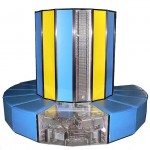Comparing apples with apples
I often joke about having a “supercomputer” on my desk. It is actually a moderately powerful desktop PC, which is not really stretched by the work that I expect it to do. But, at least I am not normally left twiddling my thumbs waiting for it to do something. I have this computer, instead of a powerful laptop, as I concluded that, when traveling, I did not need to lug an enormous computer around; a small notebook [netbook] is quite sufficient and, nowadays, my iPad can be even better.
But, I digress. What I am interested in is the comparison of my modest PC with a supercomputer and how that rates against embedded devices …
I recall that, while a student at university, I was playing with a mathematical puzzle and enlisted the help of a supercomputer in a remote city to do my calculations. I sent off the “job” and, after a couple of days, I got a printout back saying that I had consumed my quota of 20 minutes of CPU time, but not arrived at a solution. I have often wondered just home much computing power I had had access to. Now I have an idea.
Let’s consider a typical [quite high end] embedded processor: the Zynq Cortex-A9 [ARM processor embedded in a Xilinx FPGA device]. It is a dual core device running at 800 MHz. It has a theoretical peak floating point performance [single precision] of 12.8 GFLOPS. It consumes around 1 Watt of power.
Now, compare that with a desktop PC CPU – an Intel “Ivy Bridge”. This is a quad core device running at 3.5 GHz. It has a theoretical peak floating point performance [single precision] of 224 GFLOPS. It consumes around 80 Watts of power.
 So, this illustrates the wide range of performance options with modern CPUs. How does this compare with a 1980s supercomputer? Let’s consider a Cray X-MP. This was a dual core machine running at 105 MHz. It has a theoretical peak floating point performance [double precision] of 200 MFLOPS. It consumes around 60 Kilowatts of power.
So, this illustrates the wide range of performance options with modern CPUs. How does this compare with a 1980s supercomputer? Let’s consider a Cray X-MP. This was a dual core machine running at 105 MHz. It has a theoretical peak floating point performance [double precision] of 200 MFLOPS. It consumes around 60 Kilowatts of power.
Things have changed! Clearly, the description of my desktop PC is not unreasonable and maybe I need to revisit my mathematical puzzle. I guess that what I learn from this is that engineers who complain that they have not got enough CPU power for their embedded application do not know when they are well off.
Thanks to my colleague Brooks Moses for drawing my attention to these statistics.